Firearms and Ammunition
How to Bury Your Stuff: The Ultimate Guide to Burying Your Guns and Ammo
Because no one can take what they cannot find
If you haven’t read it yet, I recommend reading my General Tips page before burying firearms or ammunition.
When burying firearms and ammunition, the key is to prevent moisture from damaging either steel or gunpowder. Obviously they need to be waterproofed completely so as to not allow contact with rainwater. Unfortunately, air also contains water and it’s going to be tough to absolutely isolate an entire firearm or a box of cartridges from any and all air. This is why stable temperatures are so important and why I constantly stress burying below the frost line and using some sort of insulation.
Keeping desiccant with your ammunition can be a lifesaver when storing ammo above the frost line or for longer than a few years. After sealing your desiccant and ammo together, you’ll also need a temperature buffer. Use dead air like a beer cooler to insulate against condensation or wrap your sealed ammo up in a cotton towel. Drop the wrapped up towel into an ammo can or Tupperware or Rubbermaid container. When using plastic totes, I recommend sealing the lid with silicone.
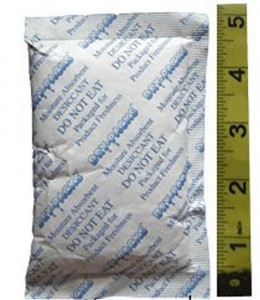 >> Click here to get current pricing and reviews from Amazon.com on Desiccant Packs <<
>> Click here to get current pricing and reviews from Amazon.com on Desiccant Packs <<
Using desiccant with firearms isn’t as critical as long as you’re digging deep. I always instruct people to just “over oil” the weapon and wrap it in an rag before sealing it inside a watertight container. It is however, more popular to grease your firearm thoroughly. Before doing so, remove anything made of wood (stock, grip or forearm), unload it and make sure that you dry-fire your weapon, you won’t want to leave the hammer-spring under tension. Ensure that your magazines are unloaded and your firearm’s action or slide is forward.
Completely coating/injecting a firearm with wheel bearing or white lithium grease is the most popular and effective way of preserving your guns, just be sure that you have the materials necessary to remove the grease. Keep in mind that removing any type of grease from any firearm will probably take more than a few moments; if you personally feel as though you may need your firearm quickly, then consider an alternative to grease.
Greasing firearms or purging your caches with nitrogen is probably a good idea if you intend to leave them underground for more than a couple years. Packing plenty of desiccant or silica-gel is another option; every little bit helps. When deciding on which method to use, consider how deep you are digging and how long the cache will be left unattended. If you are storing stainless-steel firearms below the frost line, then the “extras” aren’t really necessary although I must admit, I use them anyway.
If you are burying a rifle or shotgun and can afford Pelican cases then I suggest getting one, they have an excellent reputation. If not, PVC pipe will do equally as well provided the weapon will fit inside the tube. Remember that if you’re not greasing your firearms to always wrap them in something; a blanket or some bath towels, don’t just toss it in a piece of PVC pipe. As soon as I can, I plan on adding a step-by-step instructional page about burying long guns.
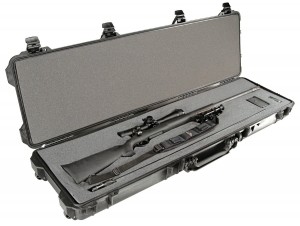 >> Click here to get current pricing and reviews from Amazon.com on Pelican Case Model 1750 <<
>> Click here to get current pricing and reviews from Amazon.com on Pelican Case Model 1750 <<
If you are burying a pistol, I recommend the military-issue ammo cans. Handguns are much easier to deal with when caching underground since they are much smaller; this equals less digging and easy covert transportation to and from the cache site.
Want my personal advice on burying a handgun? Oil the hell out of it, wrap it in a T-shirt and drop it an a military-issue ammunition can with a good rubber seal and bury it BELOW the frost line but no deeper than 5 or 6 feet. It sounds too simple and I’ve had people question this advice over the years; but never had any complaints from anyone who’s followed it.
In the first photo shown below, I show a Remington 1911 R1, a box of 100 .45 caliber cartridges, an ammo can and two cotton T-shirts. If I were burying this gun for less than three years, I would simply wrap it (and the ammo) with the T-shirts just as you see in the second photo. Dig it up every couple of years to oil it thoroughly and you won’t have any problems. I’ll go into greater detail about using surplus ammo cans on a separate webpage.
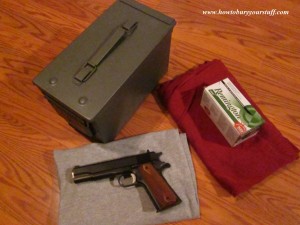
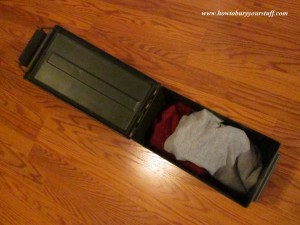
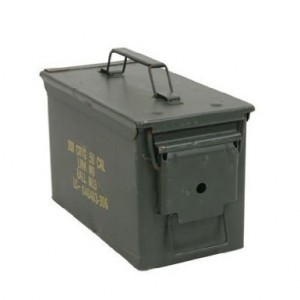 >> Click here to get current pricing and reviews from Amazon.com on 50 Caliber Ammo Cans <<
>> Click here to get current pricing and reviews from Amazon.com on 50 Caliber Ammo Cans <<
Take care when burying optical devices like rifle scopes, binoculars or night-vision optics. Use desiccant generously, make sure you use plenty of temperature insulation and make sure it’s waterproof.
The very best way to bury ammo?…In my humble opinion, loose cartridges and desiccant sealed with a FoodSaver bag; then temperature-insulated with a towel and waterproofed again inside another container. I would advise this method if you’re burying above the frost line or you’re intending to leave the ammo underground for many years. The photo below is just an example, obviously one could put more than twenty rounds in each bag.
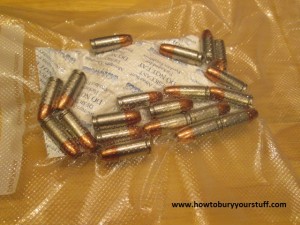
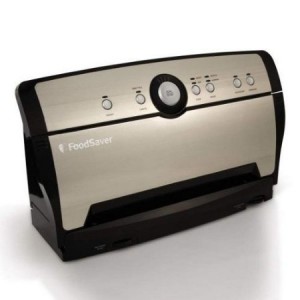 >> Click here to get current pricing and reviews from Amazon.com on FoodSaver V3820 <<
>> Click here to get current pricing and reviews from Amazon.com on FoodSaver V3820 <<
On this page, I’ve mentioned several popular methods of caching guns and ammo underground and if you’re new to the idea of burying firearms and ammunition, then this may all sound confusing. Are you wondering which one would I use? Which method is simple yet still works? Which method have I personally seen 100% positive results when done correctly? The answer is any one of them but I prefer PVC pipe for long guns or military surplus ammo cans for handguns. No grease and no nitrogen; just oil the weapon and wrap it in something cotton; blankets or T-shirts. I’d seal my ammo in FoodSaver or Zip-Loc bags with desiccant and pack even more desiccant around the firearm.
I would bury the cache between 4 or 5 feet down and feel comfortable leaving it for 8 to 10 years. If it was a blued-steel gun (like the 1911 shown above) then you would find surface-oxidation or discoloring after that long underground, but the gun would still shoot. If it were a newer gun like a Glock or any stainless-steel firearm, it wouldn’t look a bit different.
I don’t recommend leaving any underground caches unattended for more than a few years. The soil moves and the landscape changes. Come back after 15 years and you may not be able to find your cache. If you are unable to dig up your guns and check them out every 2 or 3 years, and if you need long term storage, then you might consider grease, cosmoline or nitrogen-purging. Need them to go undisturbed for 20 or 30 years? Then I’d recommend completely covering AND injecting grease into every crevice of your firearm.
Ready to dig? Break out your storage tote, PVC pipe, beer cooler or ammo can and place your wrapped guns and ammunition inside. When burying guns and ammunition underground for longer than five years, I recommend adding about 12 inches to whatever frost line is suggested for your area; but just dig as deep as comfortably possible. The deeper you go, the stronger your containers must be; but the trade-off in depth is worth the extra work to reach more stable temperatures.
 How to Bury Your Stuff
How to Bury Your Stuff